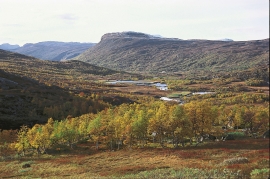- Remove Quarns and mills filter Quarns and mills
- Remove Wetland filter Wetland
- Remove Stord filter Stord
- Remove Eidfjord filter Eidfjord
- Remove Basement rocks filter Basement rocks
- Remove Fjell, frå 2020 del av nye Øygarden kommune filter Fjell, frå 2020 del av nye Øygarden kommune
- Remove Iron age filter Iron age

Hæreid- archaeology
The biggest prehistoric burial site in Hordaland is situated at Hæreid. On top of the terrace expanse, inside the fine birch garden, is where they lie, the mounds and stone piles, on their own or in clusters, large and small, round and elongated – at least 350 in all.

Halne
At Halnefjorden, a few hundred metres east of Halne mountain lodge, lie the remains of two stone sheds – Halnelægeret. Some generations ago the cattle drovers stopped here in the summer; they were the cowboys of their time. But Halnelægeret already had a long history before the cattle drovers came.

Langavassmyrane
The Ruff lek on Langvassmyrane is the only known phenomenon of its kind on Hardangervidda. Every year it attracts hens from the whole plateau. The marsh is also the richest wetland in the county. This green oasis is located in a rocky moraine landscape a few hours walking distance south of Dyranut.


Sysendalen
If you are lucky you can find 9000-year-old pine stumps on Hardangervidda. Since that time, the tree line has continuously declined. But now, it is on its way back up again.

Haganes
The gneiss landscape west and north of Bergen viewed in profile can remind us of a saw blade of the kind that has long, slanted sides that get broken off shorter transverse sides. It has taken several hundred million years to file this saw blade, an enduring interplay between various geological processes.


Tveitavatnet
It is difficult to imagine that a plant can grow at the same place for many thousands of years: Climate and local environment change. Different species grow up and die out. Nonetheless, some plants get established, but don't manage to spread into new areas, because the climate is at the edge of what they can tolerate. Great fen-sedge is just such a plant.

Ådlandsvatnet
Plants that grow in and beside water have to be prepared for marked and rapid changes in their living conditions. They must be able to tolerate living under water without drowning, and getting totally dried out without whithering. Many swamp plants are well adapted to these kinds of changes.


